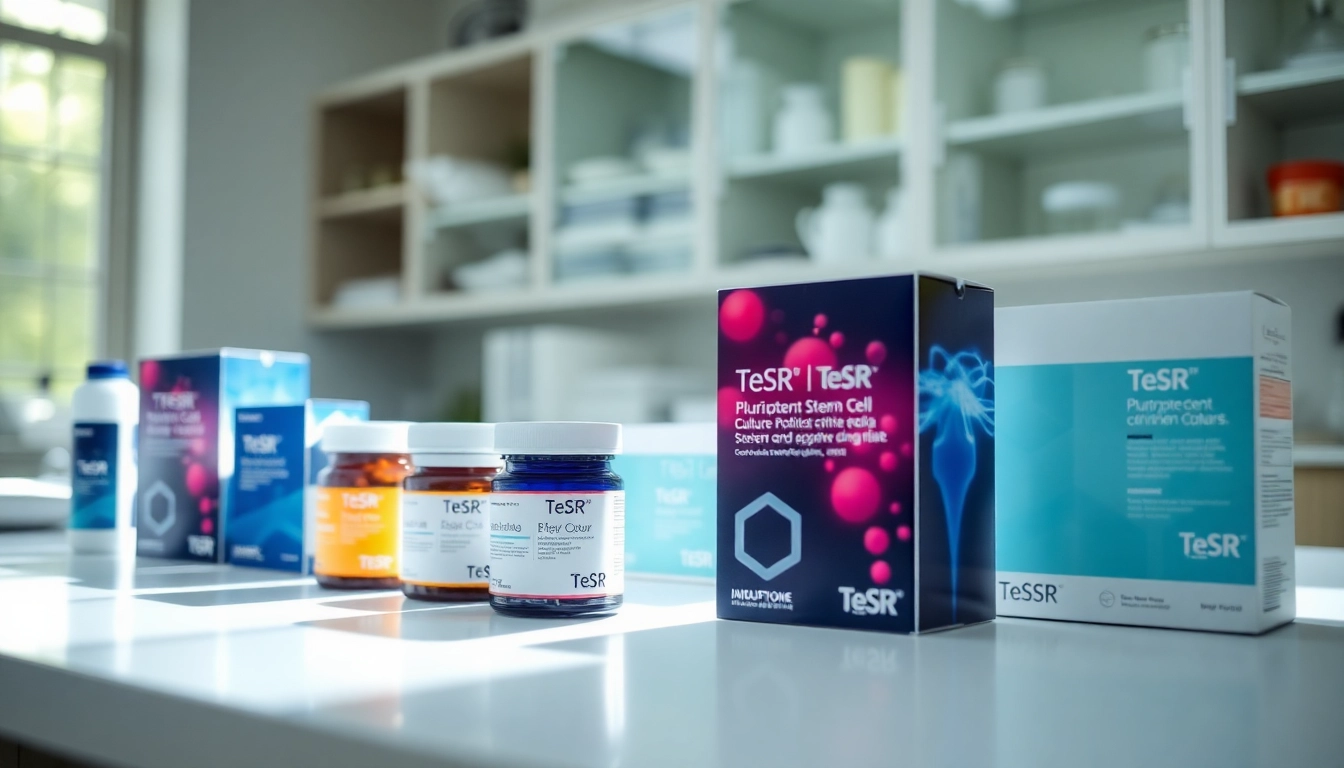Understanding TeSR™ Feeder-Free Media
The advancement of regenerative medicine and stem cell research has underscored the necessity for reliable and effective culture systems. One of the pivotal developments in this field is the advent of TeSR™ feeder-free media designed specifically for human pluripotent stem cells (hPSCs). This article provides a comprehensive overview of the TeSR™ family, emphasizing its roles in the reprogramming, maintenance, and differentiation of embryonic and induced pluripotent stem cells (iPSCs). With options like mTeSR™ Plus, TeSR™-AOF, and others, researchers now have unprecedented tools to ensure the highest quality and reproducibility in their studies. For comprehensive insights on this topic, one can find valuable resources for stem cell cultures at all check.
What are Pluripotent Stem Cells?
Pluripotent stem cells possess the unique ability to differentiate into any cell type in the human body, making them invaluable for research and therapeutic applications. They can be derived from both embryonic stem cells (ESCs) and induced pluripotent stem cells (iPSCs). ESCs are obtained from the inner cell mass of early embryos, whereas iPSCs are genetically reprogrammed somatic cells that exhibit similar capabilities to ESCs. The versatility of hPSCs has allowed significant strides in understanding developmental biology and regenerative medicine.
The Need for Feeder-Free Culture Systems
Traditional methods of culturing pluripotent stem cells relied heavily on feeder layers—layered cells that support cell growth and pluripotency. However, these feeder systems sometimes introduce variability and complicate downstream applications, particularly when isolating specific cell types for research or therapeutic purposes. Feeder-free systems, such as TeSR™, offer a defined environment that eliminates the uncertainties associated with animal-derived feeders, ensuring better control over the culture conditions and enhanced reproducibility across experiments.
Introduction to TeSR™ Media Types
The TeSR™ family comprises several variants tailored to various applications in stem cell research. These include:
- TeSR™-E8™: This media type facilitates the maintenance of hPSCs with minimal components, focusing on the essential growth factors while omitting unnecessary proteins.
- mTeSR™ Plus: This version enhances cell viability and performance with its improved buffering system and is designed for greater convenience in cell maintenance.
- TeSR™-AOF: Animal Origin-Free, this medium ensures that researchers can work in a stringent, xeno-free environment.
- mFreSR™ and FreSR™-S: Covering the cryopreservation needs for hPSCs, these formulas provide optimal conditions for preserving cell viability during freezing and thawing.
Benefits of TeSR™ Media for hPSC Maintenance
Enhanced Consistency and Reproducibility
The rigorous formulation of TeSR™ media ensures that each batch maintains a high level of consistency, enabling reproducibility essential for scientific research. Researchers using TeSR™ products benefit from reliable results across experiments, attributable to strict quality control processes implemented during production. This consistency fuels the confidence needed for researchers to make impactful discoveries in stem cell biology.
Improved Cell Growth and Health
One of the standout features of TeSR™ media is its ability to improve the growth and overall health of hPSCs. Studies indicate that cells cultured in TeSR™ media show better morphology and significantly higher rates of proliferation compared to traditional media. Enhanced cell health translates to improved research outcomes, whether in drug screening, disease modeling, or cell-based therapies.
Applications in Research and Therapy
The versatile nature of TeSR™ media makes it applicable across various domains. Researchers utilizing hPSCs in regenerative medicine can manipulate these cells into specific lineages or tissues, facilitating the development of potential treatments for diseases such as diabetes, Parkinson’s, and cardiac disorders. Moreover, the rigorous safety profiles established by using TeSR™ media enable translational research, moving discoveries closer to clinical applications.
Exploring mTeSR™ Plus and Its Features
Unique Formulation Advantages
mTeSR™ Plus represents the next generation of maintenance media. Compared to traditional formulations, it boasts enhanced pH buffering capabilities, allowing for more extended media change intervals without a significant risk of pH drops that can compromise cell viability. This unique characteristic also minimizes disruptions in daily lab routines, providing flexibility for researchers.
Comparative Analysis with Other Media
When compared to other feeder-free media available on the market, mTeSR™ Plus showcases superior performance metrics. In clinical trials and peer-reviewed studies, it has consistently shown better maintenance of pluripotency markers and increased yield of viable cells. Users have reported that transitioning from traditional media to mTeSR™ Plus resulted in smoother workflows and less labor-intensive culture protocols.
User Testimonials and Success Stories
Numerous laboratories have shared success stories around integrating mTeSR™ Plus into their cell culture practices. For instance, one research group focused on cardiomyocyte differentiation noted an improved efficiency in generating heart cells from iPSCs, attributing their success largely to the use of mTeSR™ Plus. Testimonials highlight increased cell viability and overall improved reproducibility of results, making mTeSR™ Plus a preferred choice among stem cell researchers.
Reprogramming and Differentiation Applications
Key Techniques in Cell Reprogramming
Reprogramming somatic cells into iPSCs is a feat of significant importance, allowing for the broader access to patient-specific cell lines. Key techniques such as the use of Yamanaka factors (Oct4, Sox2, Klf4, and c-Myc) are essential in initiating this transformation. TeSR™ media, especially formulations like TeSR™-E7™, optimize this process and enhance the efficiency of obtaining high-quality iPSCs.
Optimal Differentiation Strategies
Once reprogrammed, guiding hPSCs to differentiate into desired cell types requires strategic media choice and refined biological cues. TeSR™ provides several downstream differentiation media, like TeSR™-E6 and TeSR™-E5, designed for specific pathways (e.g., neuroectodermal, mesodermal). A comprehensive understanding of the conditions required for differentiation will improve the outcomes and facilitate the study of disease phenotypes.
Success Metrics and Research Outcomes
Tracking the success of differentiation protocols is crucial. Metrics such as yield, purity, and pluripotency are often assessed through flow cytometry and gene expression analysis. Researchers employing TeSR™ media have reported improved success rates in deriving specific cell types, enhancing the quality of research and increasing the potential for clinical application.
Maintaining Quality Standards in Stem Cell Research
Quality Control Measures for hPSC Media
Quality assurance in manufacturing stem cell media is paramount. Stem cell lines are sensitive; therefore, the integrity of the culture media directly impacts research outcomes. TeSR™ media undergo stringent quality control testing to ensure consistent batch quality and avoid contamination risks. These measures ensure that research can progress with confidence and reliability.
Collaborative Work: Industry Partnerships
STEMCELL Technologies fosters collaboration with academic and industry partners to continually advance stem cell research. Building a bridge between researchers and manufacturers allows for ongoing feedback on media performance and innovation. This collaborative approach has spurred the development of specialized media tailored to emerging research needs.
Future Directions in Stem Cell Media Development
The future of stem cell media development holds significant promise. Continued research into biomaterials, synthetic alternatives, and growth factor identification will likely yield even more refined products that cater to specific research needs. Maintaining compliance with cGMP standards will also be critical as products transition to clinical applications, ensuring that all systems are in place for safe and effective therapies.



